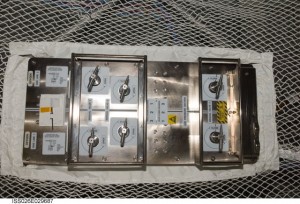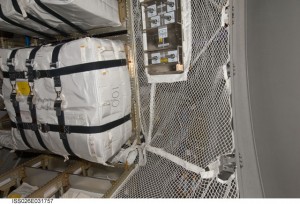More details this morning on Friday’s O2 release from ATV’s Oxygen tank No. 1 – the first repressurisation of the ISS’s internal atmosphere conducted by ATV Johannes Kepler. ATV Crew Instructor Liliana Ravagnolo, based at ESA’s European Astronaut Centre in Germany, sent in the details below – she trains the astronauts on ATV attached phase operations and is now serving as ‘crew representative’, i.e. point of contact, for any technical/procedural questions.
Since this was the first gas delivery from ATV Johannes Kepler, ESA astronaut Paolo Nespoli had first of all to unlock the valves of Gas Line 1 (the one selected for the Oxygen discharge). The locking device is provided to avoid any inadvertent opening of the valves due to launch vibrations. After that he had to check that the AED (a flexible hose) was connected to the Gas Control Panel (GCP) inside ATV to insure the proper air flow to distribute the Oxygen into the ATV cabin and then into the ISS.
In fact it is very important to avoid oxygen pockets – that can be very dangerous! Then, Paolo measured the pressure with the portable manometer – the Russian portable pressure sensor (it’s very precise) – to determine the starting pressure of the atmosphere inside the ISS. Once the ‘GO’ was given from ground, he opened the valves and left them opened almost three hours, as Charlotte mentioned in the earlier blog post. This allowed the expelled O2 to boost cabin pressure, reaching the planned ‘delta pressure’ (change in pressure) of 10 mmHg (10 mm Mercury equivalent) required for this operation.
The activity required about half an hour more then planned because it was scheduled until 19:15, but at that time the crew reported a delta pressure of only 8.5 mmHg so they continued for an additional 30 minutes more. Once every hour, Paolo came back to ATV to check that there was no condensation – no problems were reported. At the end, he closed the valves – but this time without locking them, since that’s no longer necessary.



 Automated Transfer Vehicle page
Automated Transfer Vehicle page ATV blog archive
ATV blog archive
Discussion: no comments